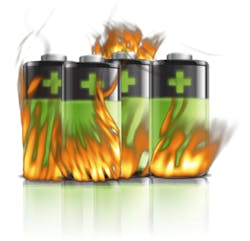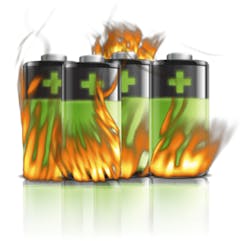Lithium-ion batteries have been in the news lately because of the fires that have grounded Boeing’s Dreamliner fleet. Potential fire problems with the batteries have long been evident, with millions of laptop batteries being recalled in 2006, although concerns in the consumer space had largely abated. Nevertheless, the Dreamliner experience refocuses attention on the potential hazards of the Li-ion technology.
Battery-Laden Passengers
In a phone interview, Hurley said, “It’s interesting that when I first heard about the connection with the Dreamliner fires and Li-ion batteries, my first thought was, on any given flight there are hundreds of Li-ion batteries onboard that the passengers bring themselves.” He explained, “There’s almost a one-to-one correspondence between passengers and cellphones, and then you add in probably a good 30% to 50% having laptop computers or tablets or other devices like that, so there are probably hundreds of these batteries on any given flight.”
Regarding the improved safety record of Li-ion batteries in laptops and cellphones, Hurley said, “I think what it comes down to is, just like any other new technology, battery technology evolves, and people learn more about how they work or how they might not work, and then people go about designing ways make them safer in the future.”
Hurley pointed out that he is a fire safety expert—not a battery expert (see the online version of this article for more on the Society of Fire Protection Engineers). Consequently, he doesn’t focus much on individual batteries in individual products. Hurley explained, “Let’s say you are the manufacturer of the cellphone, and you basically get batteries shipped to you by the pallet-load. That creates a challenge for the fire protection engineer because it’s possible that if you have a battery failure and there is a bunch of batteries in close proximity, the failure of one could lead to a failure of adjacent batteries.”
Such scenarios, he said, are what fire-protection engineers are looking at now. “That really is an area of active research. Initial indication is that some of the tried-and-true fire-safety strategies that we use all the time—like the fire sprinkler systems that you might find in a typical office building or hotel—may be the best approach, but we’re still doing research in terms of how much water should be delivered and those kinds of things.”
Hurley pointed out the challenges of conducting such research. “These tests aren’t cheap,” he said. “When you think about a pallet-load of batteries—that can be a big chunk of change, so you are careful about how you do the test so that you get the test right the first time.”
Battery Failure Causes
Writing in a recent issue of Fire Protection Engineering,1 R. Thomas Long, P.E., and Michael Kahn, Ph.D., of Exponent Failure Analysis Associates, and Celina Mikolajczak, P.E., a battery consultant, elaborated on what can cause battery failure: thermal abuse (external heating), mechanical abuse (denting or dropping), electrical abuse (an overcharge or over-discharge condition or an external short circuit), poor electrochemical design (such as an imbalance between positive and negative electrodes), and manufacturing defects (such as foreign metallic particles or poor electrode alignment).
And Hurley suggested an additional potential problem—related to electrical abuse. He said he has heard anecdotal evidence that an aftermarket battery may not play well with protective circuitry designed for the original battery.
Failures, Long, Kahn, and Mikolajczak wrote, can result in increases of cell temperature and pressure. Subsequently, the cell may undergo venting, vent gasses may ignite, contents may be ejected, and thermal runaway may propagate to adjacent cells.
The authors concurred with Hurley on the difficulty of conducting battery-fire research, citing several reasons for the lack of large-scale test data: “The Li-ion cell industry has been evolving rapidly, so there has been an inherent difficulty in defining an ‘average’ cell, battery pack, or device. Thus, if testing were to be conducted and considered reasonably comprehensive, it would require testing of multiple models of cells, packs, or devices from multiple suppliers, and even so might quickly become obsolete as cell chemistries and mechanical designs evolve.”
FAA Tests of Lithium Batteries
In another recent issue of Fire Protection Engineering,2 Constantine Sarkos of the Federal Aviation Administration reported that the FAA has conducted tests on nonrechargeable primary, or metal, batteries and on rechargeable Li-ion batteries. “With either type of battery,” he wrote, “thermal runaway of a single battery in a typical cardboard shipping box resulted in thermal runaway and ignition of the remaining batteries in the box.”
The metal battery fires were found to be far more hazardous, he added, noting, “Halon 1301, the fire extinguishing agent in passenger aircraft cargo compartment fire suppression systems, has no observable effect on a metal battery fire.” As a consequence, Sarkos wrote, “Because of the inability of a halon fire suppression system to control a metal battery fire, an Interim Final Rule was issued that prohibits the bulk shipment of metal lithium batteries on passenger-carrying aircraft.”
Research is continuing in aviation and other applications areas. As this article goes to press, Boeing is reported to have decided to test its revamped battery system in accordance with a tough Radio Technical Commission for Aeronautics (RTCA) standard, published in 2008, that the company did not make use of in its tests of the original battery system specified in 2007.3 The RTCA standard is titled Minimum Operational Performance Standards for Rechargeable Lithium Battery Systems.4 It describes “minimum operational performance standards for rechargeable Lithium battery systems to be used as permanently installed power sources on aircraft” and addresses factors such as chemical composition, cell size, cell construction, cell interconnection, venting provisions, operational and storage environments, packaging, handling, and test.
Long, Kahn, and Mikolajczak reported that the Fire Protection Research Foundation “is currently preparing for Phase II of the Li-ion Hazard and Use Assessment, which will likely involve fire tests aimed at determining the fire behavior characteristics of bulk packaged Li-ion batteries with the end goal of determining commodity classifications, as appropriate, for various Li-ion battery products.” Commodity classifications, as described by the National Fire Protection Association in NFPA 13: Standard for the Installation of Sprinkler Systems, address sprinkler-system and storage requirements.
Research will continue. Long, Kahn, and Mikolajczak cited the proliferation of electric vehicles, with charging stations in public areas and in residences, further noting that batteries may be stored at battery-switching locations, thereby posing “high-voltage and fire safety challenges in addition to those associated with Li-ion batteries themselves.” Further, they noted, the batteries are being deployed in grid stabilization systems,5 which may include integrated fire-suppression systems.
As the batteries proliferate, battery designers, designers of battery charging and monitoring circuitry, failure analysis engineers, and fire-protection engineers will all have a role to play.
References
- Long, R.T., Kahn, M., and Mikolajczak, C., “Lithium-Ion Battery Hazards,” Fire Protection Engineering, Oct. 7, 2012.
- Sarkos, C. “Research-Derived Aircraft Fire Safety Improvements (2000-2010),” Fire Protection Engineering, Feb. 21, 2013.
- Alwyn, S. and Henderson, P., “Boeing puts 787 battery to tough tests it once avoided,” Reuters, March 18, 2013.
- “Minimum Operational Performance Standards for Rechargeable Lithium Battery Systems,” RTCA, March 13, 2008.
- Blume, P., Lindenmuth, K., and Murray, J., “Power Grid Energy Storage Testing Part 1,” EE-Evaluation Engineering, November 2012.
For More Information
Exponent Failure Analysis Associates
National Fire Protection Association
Radio Technical Commission for Aeronautics
Society of Fire Protection Engineers
The Role of Fire Protection Engineers
Morgan Hurley, technical director of the Society of Fire Protection Engineers, described fire protection engineering as a unique discipline that makes use of elements of other engineering disciplines—electrical engineering, chemical engineering, civil engineering, mechanical engineering, and so forth—with the goal of designing ways to protect people and property from fire. He personally has almost 25 years experience in the field and spent the last 15 years at the Society of Fire Protection Engineers.
Previously, he said, he worked in the design of systems to protect people and property from fires and held a job with the U.S. Coast Guard in a regulatory role. The society has about 5,000 members worldwide, with about 4,000 in the United States. U.S. institutions offering degrees in fire protection engineering include Worcester Polytechnic Institute, the University of Maryland, and California Polytechnic State University.
Fire protection engineers, said Hurley, primarily focus on the buildings and facilities that present the highest risks to people and the community. Those tend to be buildings where a lot of people might be at a time or a store with lots of expensive merchandise. “We work with big offices, hotels, residential apartment buildings, and manufacturing and other industrial facilities but not so much single-family homes,” he said. “Fire safety is certainly important in single-family homes, but they are designed in accordance with straightforward rules, and there’s not a lot of need for engineering expertise on those.”

